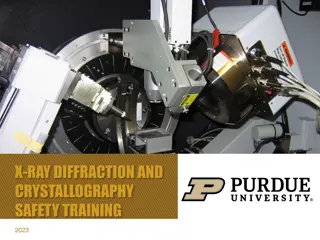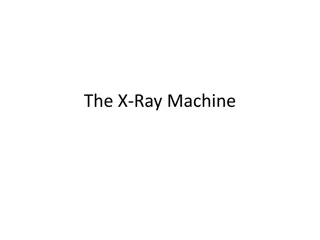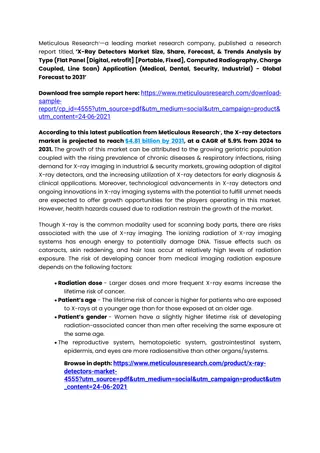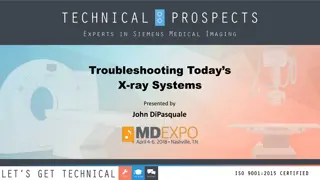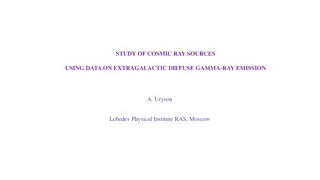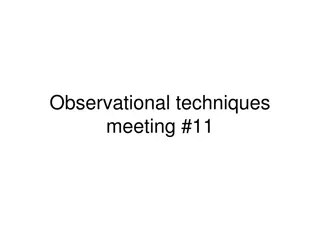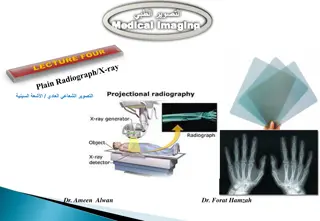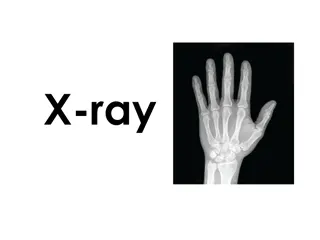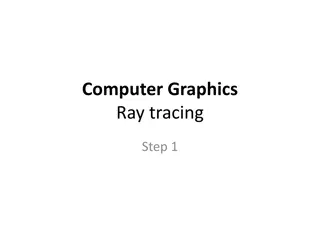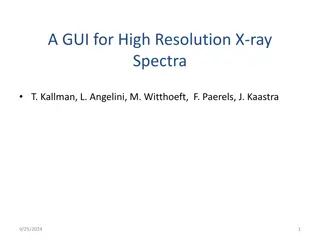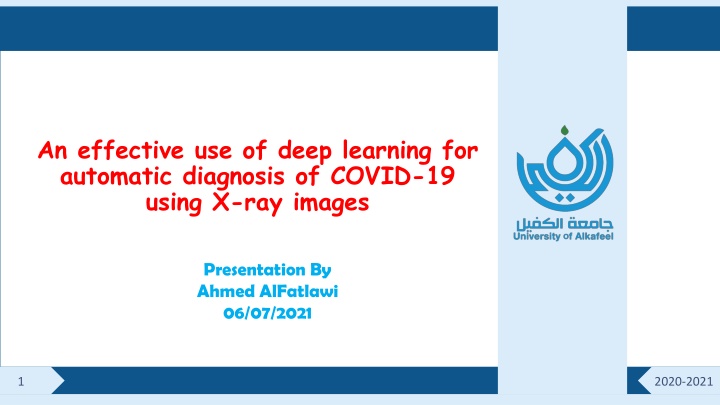
Deep Learning for COVID-19 Diagnosis Using X-ray Images
The presentation by Ahmed AlFatlawi discusses the use of deep learning through convolutional neural networks for automated diagnosis of COVID-19 using X-ray images. It explores the need for assistive methods in detecting and eradicating the spread of the virus, highlighting the efficacy of AI in medical diagnoses. The content covers the challenges of traditional diagnostic methods and the potential of deep learning techniques in enhancing healthcare practices.
Download Presentation

Please find below an Image/Link to download the presentation.
The content on the website is provided AS IS for your information and personal use only. It may not be sold, licensed, or shared on other websites without obtaining consent from the author. If you encounter any issues during the download, it is possible that the publisher has removed the file from their server.
You are allowed to download the files provided on this website for personal or commercial use, subject to the condition that they are used lawfully. All files are the property of their respective owners.
The content on the website is provided AS IS for your information and personal use only. It may not be sold, licensed, or shared on other websites without obtaining consent from the author.
E N D
Presentation Transcript
An effective use of deep learning for automatic diagnosis of COVID-19 using X-ray images Presentation By Ahmed AlFatlawi 06/07/2021 1 2020-2021
Contents Abstract Introduction Deep Learning Transfer Learning CCBlock Result 2 2020-2021 Email :info@alkafeel.edu.iq Website :http://Alkafeel.edu.iq
Abstract Troubling countries one after another, the COVID-19 pandemic has dramatically affected the health and well-being of the world s population. Therefore, it is necessary to consider developing assistive methods for detecting and diagnosing the COVID-19 to eradicate the spread of the novel coronavirus among people. Based on convolutional neural networks (CNNs), automated detection systems have shown promising results of diagnosing patients with the COVID-19 through radiography; thus, they are introduced as a workable solution to the COVID-19 diagnosis. 3 2020-2021 Email :info@alkafeel.edu.iq Website :http://Alkafeel.edu.iq
Introduction The World Health Organization (WHO) named the infectious disease caused by this type of virus the COVID-19 on Feb 11, 2020 (Sohrabi et al. 2020). It has so far been impossible to utterly know this strange virus because its behavior is entirely different. The primary method of diagnosing the COVID-19 is to conduct a polymerase chain reaction (PCR) procedure (Wang et al. 2020a), which can detect the SARSCoV-2 RNA from respiratory specimens (collected from the pharyngeal or pharyngeal tracts). 4 2020-2021 Email :info@alkafeel.edu.iq Website :http://Alkafeel.edu.iq
Introduction The PCR test is an essential standard but susceptible by type of specimen however, it is time-consuming and stressful and can be applied to a limited number of samples. Due to the huge number of infected patients and the abovementioned factors, medical imaging procedures such as the chest X-ray (CXR) and the computerized tomography (CT) scan can play a key role in diagnosing patients with the COVID-19. Therefore, it is recommended to use the chest radiography test as a diagnostic method for the COVID-19 (Ai et al. 2020). 5 2020-2021 Email :info@alkafeel.edu.iq Website :http://Alkafeel.edu.iq
Introduction The technology of digital image processing has widely been used for medical purposes such as organ segmentation as well as image enhancement and repair to provide the initial support for any subsequent diagnosis. With the rapid development of artificial intelligence (AI), deep learning techniques of automated medical diagnoses have become widely popular with specialists. Deep learning techniques have been used for many medical purposes such as the breast cancer diagnosis (Celik et al. 2020), classification of brain diseases (Talo et al. 2019), and diagnosis of pneumonia (Rajpurkar et al. 2017). 6 2020-2021 Email :info@alkafeel.edu.iq Website :http://Alkafeel.edu.iq
Deep Learning Deep learning has brought about a breakthrough in different areas of AI such as detection and identification of images, people, and sounds. The word deep indicates an increase in the number of layers where, a model that uses one or more hidden layers is called a deep model. These are called CNN models, i.e., a convolutional neural network. 7 2020-2021 Email :info@alkafeel.edu.iq Website :http://Alkafeel.edu.iq
Deep Learning Training a convolutional neural network requires large amounts of data, which are not usually available in medical diagnostic tasks. Despite the rapid and widespread prevalence and a large number of patients with the COVID-19, it is impossible to collect enough data to train neural networks from the beginning due to the harsh conditions of the pandemic. 8 2020-2021 Email :info@alkafeel.edu.iq Website :http://Alkafeel.edu.iq
Transfer Learning Transfer learning is a strategy for transferring the knowledge extracted by a neural network from specific data to solve a problem. It is applied to a new task including new and usually insufficient data to train neural networks from the beginning (Weiss et al. 2016). 9 2020-2021 Email :info@alkafeel.edu.iq Website :http://Alkafeel.edu.iq
Transfer learning There are two strategies for transferring learning: The first strategy is to use neural networks to extract important features from data while retaining the trained network architecture where the trained network outputs are the data features given to the classifier network (Huh et al. 2016). In the second strategy, the network architecture is adjusted to use its pre-trained weights attached to a parallel architecture containing untrained weights that were trained through the available data used in this study. 10 2020-2021 Email :info@alkafeel.edu.iq Website :http://Alkafeel.edu.iq
Transfer learning 11 2020-2021 Email :info@alkafeel.edu.iq Website :http://Alkafeel.edu.iq
CCBlock It is unnecessary to build a deep model from the beginning because pre-built models (VGG-16, VGG-19, and ResNet) can be modified and used. A transfer learning method is to add learnable layers at the end of the network to train it in the current data. Therefore, three learnable convolutional layers were added and trained by using the previously introduced data to improve the network performance and obtain the expected results. These three added layers were named the Convolutional COVID Block (CCBlock). 12 2020-2021 Email :info@alkafeel.edu.iq Website :http://Alkafeel.edu.iq
The procedure for the proposed model 13 2020-2021 Email :info@alkafeel.edu.iq Website :http://Alkafeel.edu.iq
Dataset For this purpose, 1828 chest X-rays were selected. The first of the three sources used in the study was Dr. Cohen dataset, were, 241 chest X-rays of the COVID-19 patients. The second source used in this study came from the Kaggle platform. It consisted of 79 chest X-rays of COVID-19 patients (Larxel 2020). As a result, there were 310 chest X-rays of the COVID-19 patients in total. 14 2020-2021 Email :info@alkafeel.edu.iq Website :http://Alkafeel.edu.iq
Dataset The third source also came from the Kaggle platform. It contained a broad set of chest X-rays for patients with pneumonia and healthy people (Mooney 2017). There were 864 chest X-rays of the patients with pneumonia: 467 images of bacterial pneumonia and 397 images of viral pneumonia. There were also 654 chest X-rays of the healthy people in the same dataset. 15 2020-2021 Email :info@alkafeel.edu.iq Website :http://Alkafeel.edu.iq
Dataset 16 2020-2021 Email :info@alkafeel.edu.iq Website :http://Alkafeel.edu.iq
Dataset 17 2020-2021 Email :info@alkafeel.edu.iq Website :http://Alkafeel.edu.iq
Result The tests were conducted on two types of databases, the first of which included two categories (COVID-19, normal), whereas the second included three categories (COVID-19, normal, and pneumonia). 18 2020-2021 Email :info@alkafeel.edu.iq Website :http://Alkafeel.edu.iq
Result 19 2020-2021 Email :info@alkafeel.edu.iq Website :http://Alkafeel.edu.iq
20 2020-2021 Email :info@alkafeel.edu.iq Website :http://Alkafeel.edu.iq

